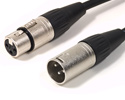Microphone signal into Guitar Amp (Hi-Z)
Posted: 24 August 2010
Comments: 0 [Post]
Synopsis: Singers and vocalists will sometimes find themselves needing to plug their microphone into a guitar amplifier. Often for practice with other band members or in the home environment.

|
Singers and vocalists will sometimes find themselves needing to plug their microphone into a guitar amplifier. Often for practice with other band members or in the home environment. A guitar amp is often a practical and inexpensive way to get your vocals amplified. They are relatively inexpensive compared to full 2-way PA systems that are generally used for vocals in a live environment. Though a guitar amp has its name for a reason; the input jack is designed for high impedance (Hi-Z) guitar signals, through a ¼" jack connector. While a microphone outputs a low impedance (Low-Z) mic level signal and the standard cable connector is a 3pin XLR. There are ways to overcome the difference in signal and cable connectors to get the correct connection and optimum signal strength from the microphone. Firstly to plug a mic into a guitar amp you will need a cable with the correct connectors on either end. Most microphones require a 3pin XLR(f) connector to plug into the bottom of the microphone. Just about all guitar amplifiers have a ¼" jack input and require a standard ¼"(m) jack connector (found on any guitar lead). Thus an XLR(f) to ¼" jack cable is needed to connect the microphone directly to the amp. |
 |
This is standard cable purchased by those wishing to plug their microphone into their guitar amp. While the connections may be correct and sound will definitely come through, there is still a difference in 'impedance' between the signal from the mic (Low-Z), and the input on the guitar amp (Hi-Z). The result is a loss of signal (voltage) which will restrict the volume to around 80% of full potential and will also reduce signal clarity somewhat.
To overcome this loss in signal due to an "impedance mis-match", there is a clever device known as an impedance transformer. The inner circuitry of the impedance transformer turns the impedance of the low-Z mic signal into hi-Z, suitable for the input on the guitar amp.












_1-4(m)_S.jpg)



 Pre-Order
Pre-Order
